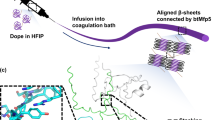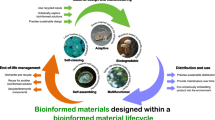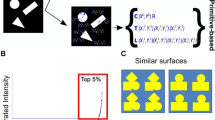Abstract
In nature, there are many strong and tough biomaterials that result from the fusion of soft and hard elements. These materials include nacre, crustacean exoskeletons and spider webs. Here, we review previous studies on such bio-fusion materials, emphasizing the importance of simple models to gain a physical understanding of the emergence of strength and toughness from these structures. Thus, a simple understanding obtained through biologically inspired models provides useful guiding principles for the development of artificial tough composites by mimicking biomaterials.
Similar content being viewed by others
Log in or create a free account to read this content
Gain free access to this article, as well as selected content from this journal and more on nature.com
or
References
Meyers, M. A., Lin, A. Y., Seki, Y., Chen, P.-Y., Kad, B. K. & Bodde, S. Structural biological composites: an overview. JOM 58, 35–41 (2006).
Fratzl, P. & Weinkamer, R. Nature's hierarchical materials. Prog. Mater. Sci. 52, 1263–1334 (2007).
Ji, B. & Gao, H. Mechanical principles of biological nanocomposites. Ann. Rev. Mater. Res. 40, 77–100 (2010).
Vincent, J. Structural Biomaterials (Princeton University Press, Princeton, New Jersey, 2012).
Sumitomo, T., Kakisawa, H., Owaki, Y. & Kagawa, Y. In situ transmission electron microscopy observation of reversible deformation in nacre organic matrix. J. Mater. Res. 23, 1466–1471 (2008).
Jackson, A., Vincent, J. & Turner, R. The mechanical design of nacre. Proc. Royal Soc. (London) B 234, 415 (1988).
Sachs, C., Fabritius, H. & Raabe, D. Hardness and elastic properties of dehydrated cuticle from the lobster homarus americanus obtained by nanoindentation. J. Mater. Res. 21, 1987–1995 (2006).
Emlet, R. Echinoderm calcite: a mechanical analysis from larval spicules. Biol. Bull. 163, 264–275 (1982).
Aizenberg, J., Weaver, J., Thanawala, M., Sundar, V., Morse, D. & Fratzl, P. Skeleton of Euplectella sp.: structural hierarchy from the nanoscale to the macroscale. Science 309, 275–278 (2005).
Hamm, C. E., Merkel, R., Springer, O., Jurkojc, P., Maier, C., Prechtel, K. & Smetacek, V. Architecture and material properties of diatom shells provide effective mechanical protection. Nature 421, 841–843 (2003).
Sarikaya, M., Liu, J. & Aksay, I. Biomimetics: Design and Processing of Materials 35–90 (AIP, New York, 1995).
Kamat, S., Su, X., Ballarini, R. & Heuer, A. Structural basis for the fracture toughness of the shell of the conch strombus gigas. Nature 405, 1036–1040 (2000).
Gao, H., Ji, B., Jäger, I., Arzt, E. & Fratzl, P. Materials become insensitive to flaws at nanoscale: lessons from nature. Proc. Natl Acad. Sci. USA 100, 5597 (2003).
Mayer, G. Rigid biological systems as models for synthetic composites. Science 310, 1144 (2005).
Currey, J. D. Bones: Structure and Mechanics (Princeton University Press, Princeton, New Jersey, 2002).
Fratzl, P., Gupta, H., Paschalis, E. & Roschger, P. Structure and mechanical quality of the collagen-mineral nano-composite in bone. J. Mater. Chem. 14, 2115–2123 (2004).
Hellmich, C., Barthélémy, J.-F. & Dormieux, L. Mineral-collagen interactions in elasticity of bone ultrastructure-a continuum micromechanics approach. Eur. J. Mech. A 23, 783–810 (2004).
Kato, T. Polymer/calcium carbonate layered thin-film composites. Adv. Mater. 12, 1543–1546 (2000).
Sarikaya, M., Tamerler, C., Jen, A., Schulten, K. & Baneyx, F. Molecular biomimetics: nanotechnology through biology. Nat. Mater. 2, 577–585 (2003).
Deville, S., Saiz, E., Nalla, R. & Tomsia, A. Freezing as a path to build complex composites. Science 311, 515–518 (2006).
Munch, E., Launey, M., Alsem, D., Saiz, E., Tomsia, A. & Ritchie, R. Tough, bio-inspired hybrid materials. Science 322, 1516 (2008).
Bonderer, L., Studart, A. & Gauckler, L. Bioinspired design and assembly of platelet reinforced polymer films. Science 319, 1069 (2008).
Corte, L. & Leibler, L. A model for toughening of semicrystalline polymers. Macromolecules 40, 5606–5611 (2007).
Li, X., Chang, W., Chao, Y., Wang, R. & Chang, M. Nanoscale structural and mechanical characterization of a natural nanocomposite material: the shell of red abalone. Nano Lett. 4, 613–617 (2004).
Barthelat, F., Li, C., Comi, C. & Espinosa, H. Mechanical properties of nacre constituents and their impact on mechanical performance. J. Mater. Res. 21, 1977–1986 (2006).
Barthelat, F., Tang, H., Zavattieri, P., Li, C. & Espinosa, H. On the mechanics of mother-of-pearl: a key feature in the material hierarchical structure. J. Mech. Phys. Solids 55, 306–337 (2007).
Meyers, M., Lin, A., Chen, P. & Muyco, J. Mechanical strength of abalone nacre: role of the soft organic layer. J. Mech. Behav. Biomed. Mater. 1, 76–85 (2008).
Okumura, K. & de Gennes, P.-G. Why is nacre strong? Elastic theory and fracture mechanics for biocomposites with stratified structures. Eur. Phys. J. E 4, 121–127 (2001).
Smith, B., Schäffer, T., Viani, M., Thompson, J., Frederick, N., Kindt, J., Belcher, A., Stucky, G., Morse, D. & Hansma, P. Molecular mechanistic origin of the toughness of natural adhesives, fibres and composites. Nature 399, 761–763 (1999).
Rao, M. P., Sanchez-Herencia, A., Beltz, G., McMeeking, R. & Lange, F. Laminar ceramics that exhibit a threshold strength. Science 286, 102–105 (1999).
Evans, A., Suo, Z., Wang, R., Aksay, I., He, M. & Hutchinson, J. Model for the robust mechanical behavior of nacre. J. Mater. Res. 16, 2476 (2001).
Song, F., Soh, A. & Bai, Y. Structural and mechanical properties of the organic matrix layers of nacre. Biomaterials 24, 3623–3631 (2003).
Okumura, K. Why is nacre strong? ii. Remaining mechanical weakness for cracks propagating along the sheets. Eur. Phys. J. E 7, 303–310 (2002).
de Gennes, P.-G. & Okumura, K. On the toughness of biocomposites. Comp. Ren. Acad. Sci. IV 1, 257–261 (2000).
Okumura, K. Fracture strength of biomimetic composites: scaling views on nacre. J. Phys.: Cond. Matt. 17, S2879 (2005).
Okumura, K. Enhanced energy of parallel fractures in nacre-like composite materials. Europhys. Lett. 63, 701 (2003).
Kotha, S., Li, Y. & Guzelsu, N. Micromechanical model of nacre tested in tension. J. Mater. Sci. 36, 2001–2007 (2001).
Katti, D., Katti, K., Sopp, J. & Sarikaya, M. 3d finite element modeling of mechanical response in nacre-based hybrid nanocomposites. Comp. Theor. Polym. Sci 11, 397–404 (2001).
Ji, B. & Gao, H. Mechanical properties of nanostructure of biological materials. J. Mech. Phys. Solid 52, 1963–1990 (2004).
Nukala, P., Zapperi, S. & Šimunović, S. Statistical properties of fracture in a random spring model. Phys. Rev. E 71, 066106 (2005).
Fratzl, P., Gupta, H., Fischer, F. & Kolednik, O. Hindered crack propagation in materials with periodically varying young's modulus from biological materials. Adv. Mater. 19, 2657–2661 (2007).
Hamamoto, Y. & Okumura, K. Analytical solution to a fracture problem in a tough layered structure. Phys. Rev. E 78, 026118 (2008).
Hamamoto, Y. & Okumura, K. Realistic numerical analysis of a bioinspired layered composite with a crack: robust scaling laws and crack arrest. Adv. Eng. Mater. 15, 522–528 (2013).
Aoyanagi, Y. & Okumura, K. Stress and displacement around a crack in layered network systems mimicking nacre. Phys. Rev. E 79, 066108 (2009).
Beyerlein, I. J., Phoenix, S. L. & Sastry, A. M. Comparison of shear-lag theory and continuum fracture mechanics for modeling fiber and matrix stresses in an elastic cracked composite lamina. Int. J. Solid. Struct. 33, 2543–2574 (1996).
Weaver, J., Milliron, G., Miserez, A., Evans-Lutterodt, K., Herrera, S., Gallana, I., Mershon, W., Swanson, B., Zavattieri, P., DiMasi, E. & Kisailus, D. The stomatopod dactyl club: a formidable damage-tolerant biological hammer. Science 336, 1275–1280 (2012).
Nikolov, S., Petrov, M., Lymperakis, L., Friák, M., Sachs, C., Fabritius, H., Raabe, D. & Neugebauer, J. Revealing the design principles of high-performance biological composites using ab initio and multiscale simulations: the example of lobster cuticle. Adv. Mater. 22, 519–526 (2010).
Fabritius, H., Sachs, C., Triguero, P. & Raabe, D. Influence of structural principles on the mechanics of a biological fiber-based composite material with hierarchical organization: the exoskeleton of the lobster homarus americanus. Adv. Mater. 21, 391–400 (2009).
Kato, T., Sugawara, A. & Hosoda, N. Calcium carbonate-organic hybrid materials. Adv. Mater. 14, 869–877 (2002).
Yamamoto, Y., Nishimura, T., Sugawara, A., Inoue, H., Nagasawa, H. & Kato, T. Effects of peptides on caco3 crystallization: mineralization properties of an acidic peptide isolated from exoskeleton of crayfish and its derivatives. Cryst. Growth Des. 8, 4062–4065 (2008).
Sugawara, A., Nishimura, T., Yamamoto, Y., Inoue, H., Nagasawa, H. & Kato, T. Self-organization of oriented calcium carbonate/polymer composites: effects of a matrix peptide isolated from the exoskeleton of a crayfish. Angew. Chem. Int. Ed. 45, 2876–2879 (2006).
Okumura, K. Simple model for the toughness of a helical structure inspired by the exoskeleton of lobsters. J. Phys. Soc. Jpn 82, 124802 (2013).
Hull, D. & Clyne, T. An Introduction to Composite Materials (Cambridge University Press, Cambridge, 1996).
Gao, H. Fracture analysis of nonhomogeneous materials via a moduli-perturbation approach. Int. J. Solid. Struct. 27, 1663–1682 (1991).
Muju, S. Crack propogation in bimaterial multilayered periodically microcracking composite media. Compos. Sci. Technol. 60, 2213–2221 (2000).
Fischer, F., Predan, J., Fratzl, P. & Kolednik, O. Semi-analytical approaches to assess the crack driving force in periodically heterogeneous elastic materials. Int. J. Fract. 173, 57–70 (2012).
Kolednik, O., Predan, J., Fischer, F. & Fratzl, P. Bioinspired design criteria for damage-resistant materials with periodically varying microstructure. Adv. Funct. Mater. 21, 3634–3641 (2011).
Gosline, J. M., Denny, M. W. & DeMont, M. E. Spider silk as rubber. Nature 309, 551–552 (1984).
Vollrath, F. & Edmonds, D. T. Modulation of the mechanical properties of spider silk by coating with water. Nature 340, 305–307 (1989).
Osaki, S. Spider silk as mechanical lifeline. Nature 384, 419–419 (1996).
Guerette, P. A., Ginzinger, D. G., Weber, B. H. & Gosline, J. M. Silk properties determined by gland-specific expression of a spider fibroin gene family. Science 272, 112–115 (1996).
Vollrath, F. & Knight, D. P. Liquid crystalline spinning of spider silk. Nature 410, 541–548 (2001).
Jin, H.-J. & Kaplan, D. L. Mechanism of silk processing in insects and spiders. Nature 424, 1057–1061 (2003).
Emile, O., Le Floch, A. & Vollrath, F. Biopolymers: shape memory in spider draglines. Nature 440, 621–621 (2006).
Zhou, H. & Zhang, Y. Hierarchical chain model of spider capture silk elasticity. Phys. Rev. Lett. 94, 028104 (2005).
Emile, O., Le Floch, A. & Vollrath, F. Time-resolved torsional relaxation of spider draglines by an optical technique. Phys. Rev. Lett. 98, 167402 (2007).
Witt, P. N. & Reed, C. F. Spider-web building. Science 149, 1190–1197 (1965).
Selden, P. Orb-web weaving spiders in the early cretaceous. Nature 340, 711–713 (1989).
Masters, W. M. Vibrations in the orbwebs of nuctenea sclopetaria (araneidae). Behav. Ecol. Sociobiol. 15, 207–215 (1984).
Lin, L., Edmonds, D. & Vollrath, F. Structural engineering of an orb-spider's web. Nature 373, 146–148 (1995).
Wirth, E. & Barth, F. G. Forces in the spider orb web. J. Comp. Physiol. A 171, 359–371 (1992).
Alam, M., Wahab, M. & Jenkins, C. Mechanics in naturally compliant structures. Mech. Mater. 39, 145–160 (2007).
Cranford, S., Tarakanova, A., Pugno, N. & Buehler, M. Nonlinear material behaviour of spider silk yields robust webs. Nature 482, 72–76 (2012).
Ackbarow, T., Sen, D., Thaulow, C. & Buehler, M. J. Alpha-helical protein networks are self-protective and flaw-tolerant. PLoS ONE 4, e6015 (2009).
Buehler, M. J. & Ackbarow, T. Fracture mechanics of protein materials. Mater. Today 10, 46–58 (2007).
Vollrath, F. & Selden, P. The role of behavior in the evolution of spiders, silks, and webs. Ann. Rev. Ecol. Evol. Systematics 38, 819 (2007).
Aoyanagi, Y. & Okumura, K. Simple model for the mechanics of spider webs. Phys. Rev. Lett. 104, 038102 (2010).
Nakagawa, S. & Okumura, K. Crack-tip stress concentration and mesh size in networks. J. Phys. Soc. Jpn 76, 4801 (2007).
Aoyanagi, Y. & Okumura, K. Crack-tip stress concentration and structure size in nonlinear structured materials. J. Phys. Soc. Jpn 78, 034402 (2009).
Soné, N., Mori, M. & Okumura, K. Scaling relation in fracture of the materials with elastoplastic response inaccessible by scaling laws. J. Phys. Soc. Jpn 81, 074604 (2012).
Kashima, Y. & Okumura, K. Fracture of soft foam solids: interplay of visco-and plasto-elasticity. ACS Macro Lett. 3, 419–422 (2014).
Acknowledgements
This research was partly supported by the Grant-in-Aid for Scientific Research on Innovative Areas, ‘Fusion Materials (area no. 2206),’ of MEXT, Japan, and by the Grant-in-Aid for Scientific Research (A) (no. 24244066) of JSPS, Japan.
Author information
Authors and Affiliations
Corresponding author
Rights and permissions
About this article
Cite this article
Okumura, K. Strength and toughness of bio-fusion materials. Polym J 47, 99–105 (2015). https://doi.org/10.1038/pj.2014.97
Received:
Revised:
Accepted:
Published:
Issue date:
DOI: https://doi.org/10.1038/pj.2014.97



